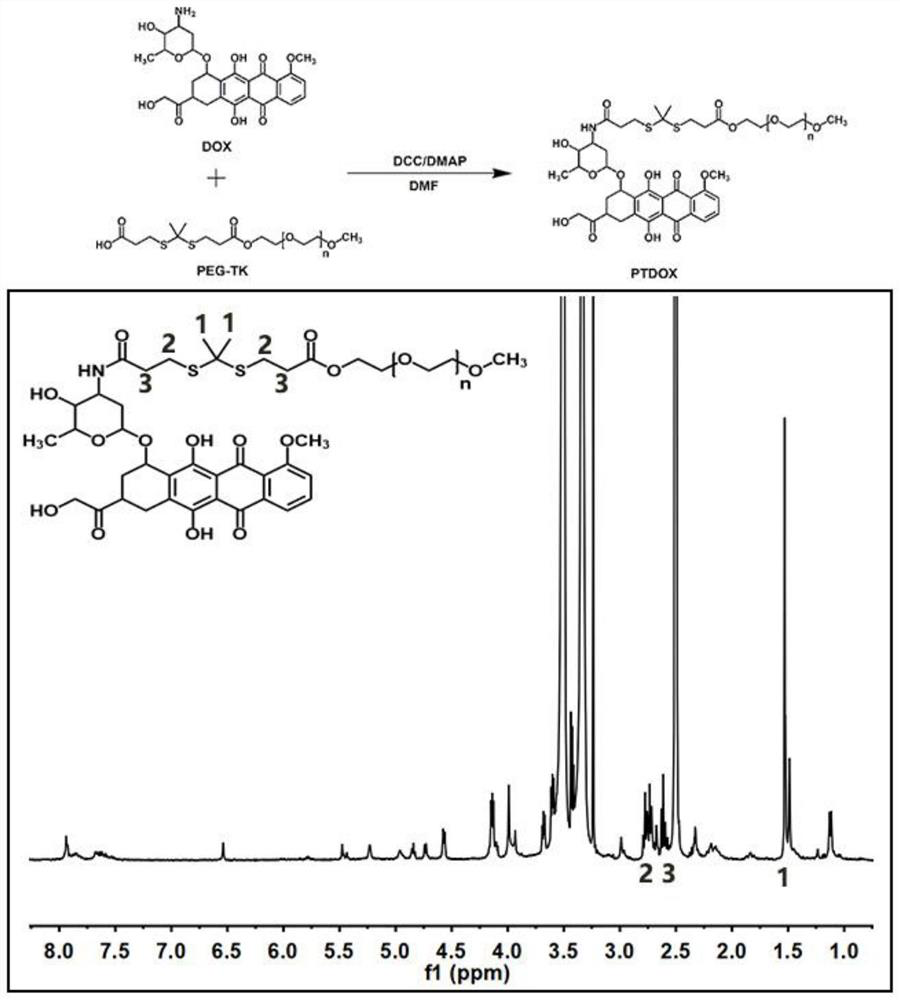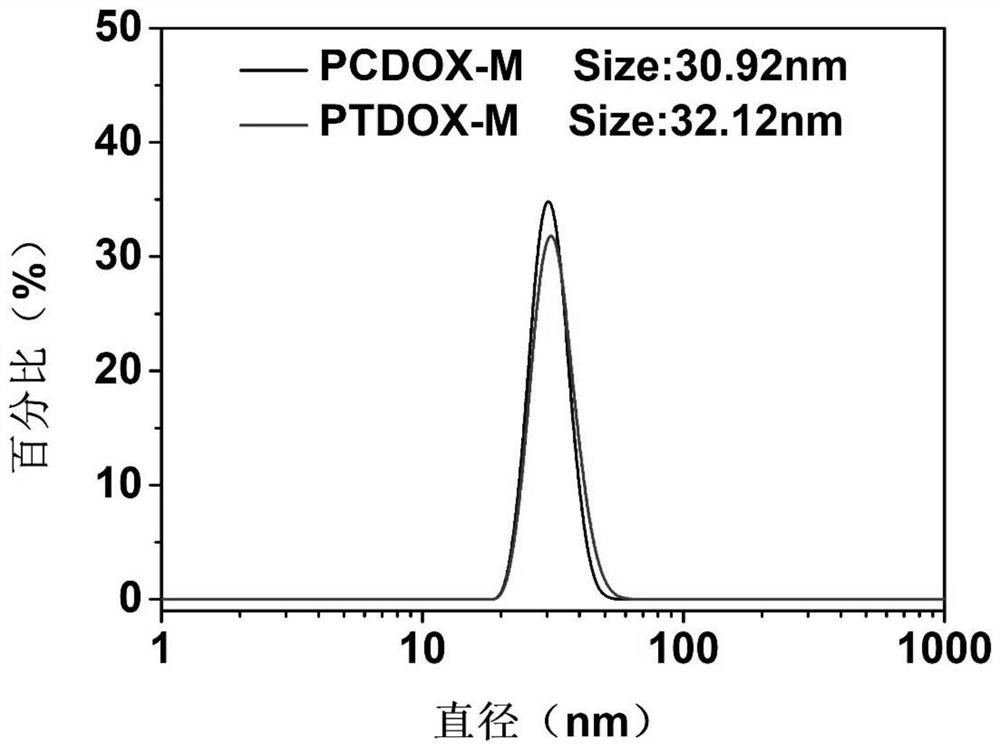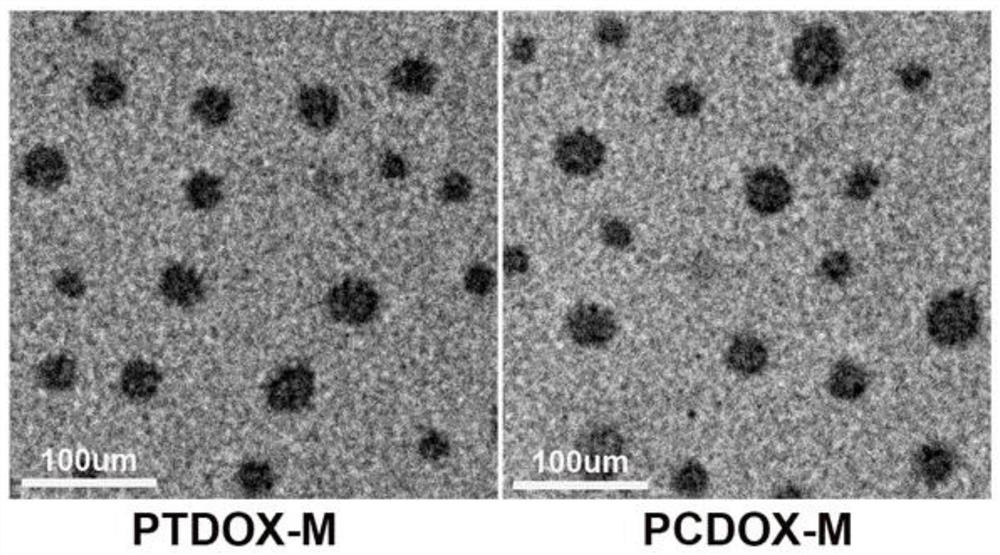Oxidation response type nano-micelle, and preparation method and application thereof
A nano-micelle, responsive technology, applied in the field of molecular medical nano-materials, can solve the problems of tumor necrosis, lack of deep soft tissue penetration ability, low toxicity and side effects, etc., to achieve prolonged residence time, highly space-time controlled drug release effect, damage reduction effect
- Summary
- Abstract
- Description
- Claims
- Application Information
AI Technical Summary
Problems solved by technology
Method used
Image
Examples
Embodiment 1
[0045] Embodiment 1: In a specific embodiment of the present invention, a method for preparing oxidation-responsive nanomicelles provided in this embodiment includes the following steps:
[0046] 1) Add 3-mercaptopropionic acid (5.2g, 49.1mmol) into anhydrous acetone (5.8g, 98.2mmol), react in dry hydrogen chloride gas, stir and react at room temperature for 4h, then place the product crystals at -20°C Freeze, wash with n-hexane and ultrapure water in sequence after freezing, and then freeze-dry to obtain dicarboxylic acid white powder COOH-TK-COOH containing sulfur ketal TK bond.
[0047] 2) Under nitrogen, disperse COOH-TK-COOH (252.1mg, 1mmol), dicyclohexylcarbodiimide (61.8mg, 0.3mmol), 4-dimethylaminopyridine (61.1mg, 0.5mol) in In 10ml anhydrous dichloromethane (DCM), obtain reaction system; Polyethylene glycol monomethyl ether mPEG 2000 (1g, 0.5mmol) was dispersed in 10ml of anhydrous anhydrous dichloromethane (DCM), and then added dropwise to the above reaction system...
Embodiment 2
[0052] Example 2: The method for preparing oxidation-responsive nanomicelles and the application of nanomicelles provided in this example are basically the same as those in Example 1, except that:
[0053] In step 1), the stirred reaction was carried out in dry hydrogen chloride gas for 6 hours; the freezing temperature was -60°C; the weight ratio of 3-mercaptopropionic acid to anhydrous acetone was 6.2g:6.8g.
[0054] In step 2), the stirring reaction time in an ice bath is 4 hours; the reaction time at room temperature is 24 hours; the dicarboxylic acid product COOH-TK-COOH, dicyclohexylcarbodia The dosage ratio of amine, 4-dimethylaminopyridine and anhydrous dichloromethane is 260mg:68mg:66mg:1ml; polyethylene glycol monomethyl ether mPEG 200 The dosage ratio of anhydrous dichloromethane is 1.2g: 11ml.
[0055] In step 3), the dosage ratio of hydrophobic drug molecule (doxorubicin hydrochloride), organic solvent, and anhydrous triethylamine is 70mg: 12ml: 18ul; the stirrin...
Embodiment 3
[0057] Example 3: The method for preparing oxidation-responsive nanomicelles and the application of nanomicelles provided in this example are basically the same as in Example 1, except that:
[0058] In step 1), the stirred reaction was carried out in dry hydrogen chloride gas for 5 hours; the freezing temperature was -50°C; the weight ratio of 3-mercaptopropionic acid to anhydrous acetone was 5.8g:6.1g.
[0059] In step 2), the stirring reaction time in an ice bath is 4 hours; the reaction time at room temperature is 36 hours; the dicarboxylic acid product COOH-TK-COOH, dicyclohexylcarbodia The dosage ratio of amine, 4-dimethylaminopyridine and anhydrous dichloromethane is 295mg:90mg:70mg:14ml; polyethylene glycol monomethyl ether mPEG 200 The dosage ratio of anhydrous dichloromethane is 1.5g: 16ml.
[0060] In step 3), the dosage ratio of hydrophobic drug molecule (doxorubicin hydrochloride), organic solvent, and anhydrous triethylamine is 80mg: 13ml: 19ul; the stirring tim...
PUM
 Login to View More
Login to View More Abstract
Description
Claims
Application Information
 Login to View More
Login to View More - R&D
- Intellectual Property
- Life Sciences
- Materials
- Tech Scout
- Unparalleled Data Quality
- Higher Quality Content
- 60% Fewer Hallucinations
Browse by: Latest US Patents, China's latest patents, Technical Efficacy Thesaurus, Application Domain, Technology Topic, Popular Technical Reports.
© 2025 PatSnap. All rights reserved.Legal|Privacy policy|Modern Slavery Act Transparency Statement|Sitemap|About US| Contact US: help@patsnap.com



